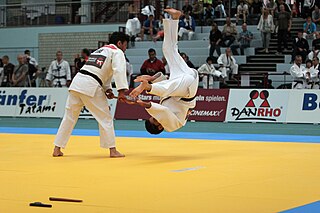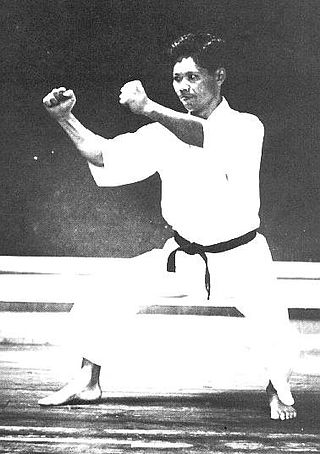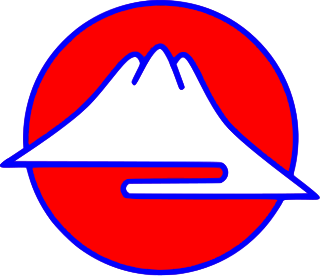This article has multiple issues. Please help improve it or discuss these issues on the talk page . (Learn how and when to remove these template messages)
|
This is a list of techniques practiced in the Shotokan style of karate.
This article has multiple issues. Please help improve it or discuss these issues on the talk page . (Learn how and when to remove these template messages)
|
This is a list of techniques practiced in the Shotokan style of karate.

Uechi-Ryū is a traditional style of Okinawan karate. Uechi-Ryū means "Style of Uechi" or "School of Uechi". Originally called Pangai-noon, which translates to English as "half-hard, half-soft", the style was renamed Uechi-Ryū after the founder of the style, Kanbun Uechi, an Okinawan who went to Fuzhou in Fujian Province, China to study martial arts and Chinese medicine when he was 19 years old.

Shitō-ryū (糸東流) is a form of karate that was founded in 1934 by Kenwa Mabuni. Shitō-ryū is synthesis of the Okinawan Shuri-te and Naha-te schools of karate and today is considered one of the four main styles of the art.

Tsuki (突き) derives from the verb tsuku (突く), meaning "to thrust". The second syllable is accented, with Japanese's unvoiced vowels making it pronounced almost like "ski". In Japanese martial arts and Okinawan martial arts, tsuki is used to refer to various thrusting techniques.
The Taikyoku series is a series of kata in use in several types of karate. The name Taikyoku (太極) refers to the Chinese philosophical concept of Taiji. The Taikyoku kata were developed by Yoshitaka Funakoshi and introduced by Gichin Funakoshi as a way to simplify the principles of the already simplified Pinan/Heian series. The embusen, or pattern of the kata's movements, are the same as in Heian shodan. Students of karate systems that use the Taikyoku kata series are often introduced to them first, as a preparation for the Pinan/Heian kata. Some Korean Tang Soo Do and Song Moo Kwan Taekwondo schools, also practice these kata (poomsae); they are termed, "Taegeuk", which is a direct Korean translation of the Kanji/Hanja characters used to write "Taikyoku". They are distinctly different from the 8 Taegeuk poomsae practiced in Kukkiwon. Gōjū Kai developed five of its own Taikyoku kata, based on the Shotokan katas and retaining the I-shaped embusen. The embusen (pathway) of all the Taikyoku kata is simple :
*--! | | | | !--#
Rōhai (鷺牌) meaning “image of a heron” or “sign of a heron” is a family of kata practiced in some styles of karate. The kata originated from the Tomari-te school of Okinawan martial arts. It was called Matsumora Rōhai, after Kosaku Matsumora, who was presumably its inventor. Ankō Itosu later took this kata and developed three kata from it: Rōhai shodan, Rōhai nidan, and Rōhai sandan. In Shorin-ryū and Matsubayashi-ryū this kata introduces Gedan Shotei Ate and Ippon Ashi Dachi. It contains a sequence of Tomoe Zuki exactly the same as the one in Bassai, although the ending of the sequence chains into Hangetsu Geri/Uke.

Kōdōkan Goshin Jutsu or Kōdōkan goshinjutsu was, before the introduction of the Kodomo-no-kata, the most recent judo kata of Kodokan - being established in 1956. Compared to Kime no kata it is a more modern set of self-defence techniques. Instead of attacks with swords, the kata contains defences against attacks with stick and pistol.

Gigō Funakoshi was the third son of Gichin Funakoshi and is widely credited with developing the foundation of the modern karate Shotokan style.
Shorin-ryu Shidokan is the main branch of Shorin-ryū style of Okinawan karate, started by Katsuya Miyahira, Hanshi 10th Dan.
Enpi (燕飛), also frequently transliterated as Empi, is a kata practiced by Shotokan and other karate styles. Enpi means Flying Swallow.
Aiki-jō is the name given specifically to the set of martial art techniques practiced with a jō, according to the principles of aikido. Jō techniques were introduced into aikido by Morihei Ueshiba, aikido's founder, and further developed by Morihiro Saito, one of Ueshiba's most prominent students.

Yoseikan Aikido is the aikido taught at the Yoseikan Dojo in Shizuoka, Japan, under the direction of Minoru Mochizuki.
Tōon-ryū is a style of Okinawan Karate founded by Juhatsu Kyoda.

Kenkojuku is a style of Shotokan karate previous to the establishment of the Japan Karate Association (JKA) style. It was founded by Tomosaburo Okano. Kenkojuku karate is similar to the teachings of Gichin Funakoshi and modifications made by Funakoshi's son Yoshitaka Funakoshi. JKA Shotokan differs slightly in that it was Masatoshi Nakayama's version of Shotokan. Okano's/Yoshitaka's Kenkojuku karate and JKA karate are becoming more similar compared to other variants of Shotokan karate such as Shigeru Egami's Shotokai, Hirokazu Kanazawa's Shotokan Karate International or SKI.

Motobu-ryū (本部流) is a karate school founded in 1922 by Motobu Chōki from Okinawa. Its official name is Nihon Denryū Heihō Motobu Kenpō, or Motobu Kenpō for short. Motobu-ryū has the characteristics of koryū karate, the martial art known as tī or tōdī, which predates the birth of modern karate, and emphasizes kumite rather than kata.
Jūkenpo is a Japanese martial art. Its name can be translated as "the Way of the soft fist" or "the soft boxing".
Aikido techniques are frequently referred to as waza 技. Aikido training is based primarily on two partners practicing pre-arranged forms (kata) rather than freestyle practice. The basic pattern is for the receiver of the technique (uke) to initiate an attack against the person who applies the technique—the 取り tori, or shite 仕手, also referred to as (投げ nage, who neutralises this attack with an aikido technique.
Atemi waza (当て身技) or body-striking techniques were the strikes from the several ancient traditional Japanese jujitsu styles that were adopted in judo by its designer Jigorō Kanō in 1882 after a comprehensive study, accompanied by uke waza or defending blocks and parries. When judo further developed as a sports discipline, these techniques were excluded from its competition repertoire, which limits itself mainly to throws and holds : although taught within self-defense, kata and sometimes used within informal randori, striking techniques are forbidden in the sport judo competitions rules.